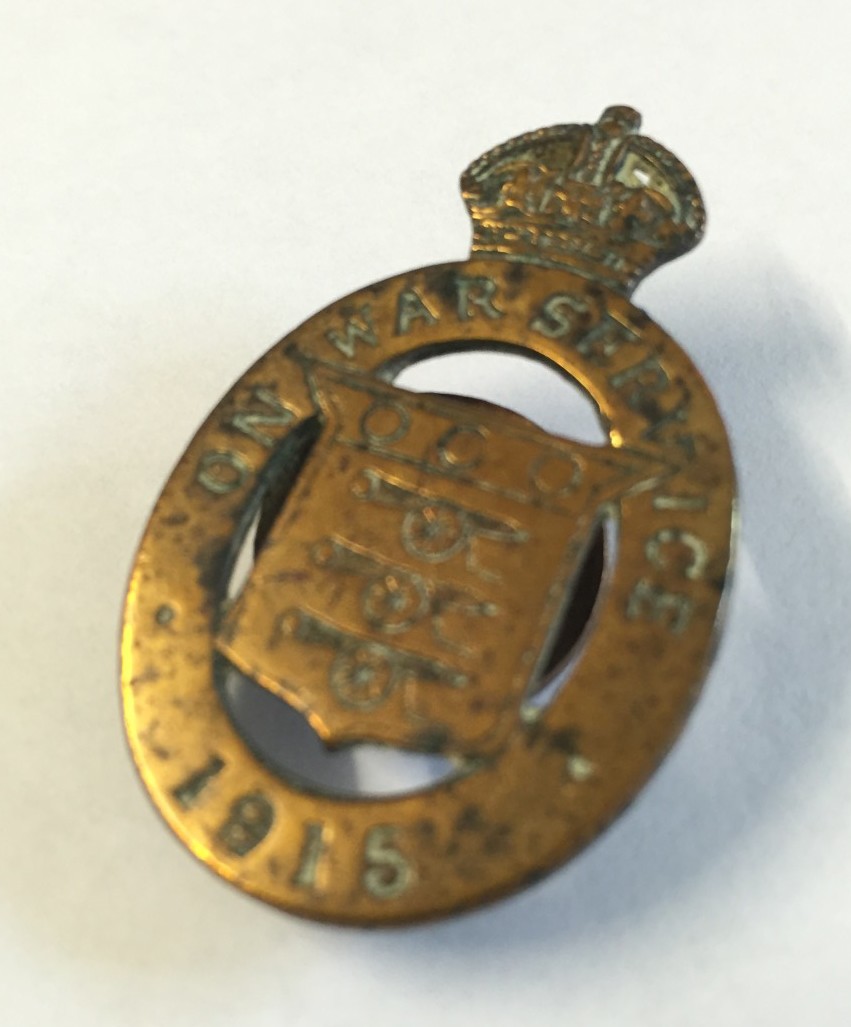On War Service badge
 This badge originates from the Royal Arsenal in Woolwich, the evidence for this being the three canons on the item which were the emblem of the Arsenal. As inscribed on the item itself, this badge would have been worn by someone ‘ON WAR SERVICE’ during the First World War (1914-1918). However, while the badge is labelled with the year 1915, this does not necessarily mean this was when it issued. Rather, the year stated relates to when the badge was first introduced to the workforce and badges with the year 1915 on them would have been given out to workers in other years too.
This badge originates from the Royal Arsenal in Woolwich, the evidence for this being the three canons on the item which were the emblem of the Arsenal. As inscribed on the item itself, this badge would have been worn by someone ‘ON WAR SERVICE’ during the First World War (1914-1918). However, while the badge is labelled with the year 1915, this does not necessarily mean this was when it issued. Rather, the year stated relates to when the badge was first introduced to the workforce and badges with the year 1915 on them would have been given out to workers in other years too.
The Royal Arsenal in Woolwich played a vital role in the British war effort, providing a substantial amount of armaments required by the nation’s military. As a result, the Arsenal saw an exponential growth during the war and it was noted at the time how ‘Woolwich booms in wartime’. According to some accounts, to meet the demands the Arsenal employed around 80,000 people during the war. This surge in workforce numbers meant that much more local housing was needed. Indeed, it was feared that there was not enough labour available in the local area to meet the quota of munitions needed by the military. This resulted in the creation of the ‘Progress Estate’ in Eltham which was designed specifically to house those who worked at the Royal Arsenal. The housing project was built at a breakneck speed and was completed in December 1915.
But why was the need felt to issue the workforce with such badges? There have been a number of reasons suggested for this. Firstly, these badges were given out to protect men, who otherwise would have been expected to sign up for military service, from being confronted in the street by women handing them white feathers and labelling them cowards. This was a sensible concern at the time as this sentiment was extremely strong and popular. For example, a personal column in The Times in 1915 has ‘Ethel M.’ threatening a man, saying that ‘If you are not in khaki by the 20th I shall cut you dead’. This is just one example of the fervent abuse men would receive if they were not seen to be fighting or contributing in some way to the nation’s war effort. It is therefore clear why distributing badges of this kind to the male munitions workforce was deemed a necessity.
Secondly, these badges were issued by institutions such as the Royal Arsenal in Woolwich in an attempt to maintain a workforce during the war. When war was declared many young men were swept up in a frenzy of national pride and duty and signed up to join the military. Therefore it was felt necessary to badge workers needed for the production of armaments in order to retain a source of skilled labour and stop them from signing up to fight. The issuing of badges to essential war workers was in part designed to instil pride and the sense that they were making a valuable contribution to the war effort.
By Gavin Bedford
Gavin Bedford is a student at Royal Holloway, University of London.

